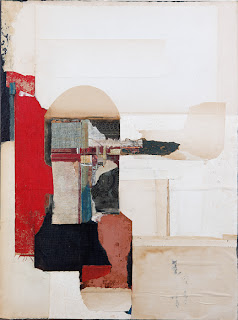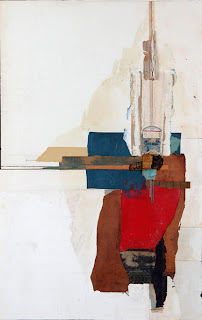By Keith Waits.
Entire contents are copyright © 2012 Keith Waits. All rights reserved.
| Teri Dryden. Photo by Mack Dryden. |
An artist’s journey is most often an irregular path following emotional or at least instinctual cues – as much or more than logic or rational processes. In the case of Teri Dryden, the first steps were into performance in a populist vein, earning laughs working as a professional clown. Yet today her creativity expresses itself in visual art, in collage work that is delicate and controlled.
The contrast that one finds in the two occupations may capture a duality that is not uncommon in many artists, and one can still detect the taste for mischief and low humor discernible in the twinkle of Ms. Dryden’s eye. “I love slapstick!”
 |
| Monteith’s Marrakech. |
So her skills as an acrobat and pantomime led her to the Ringling Brothers clown college in Florida. After graduation she received a contract to perform with the legendary circus itself, touring for two years before “retiring” at the tender age of twenty-one. Eventually her acting ambitions led her to Los Angeles, where she had meaningful impact as a stage actress, marrying comedian and actor Mack Dryden and eventually turning her attentions from the outgoing, more extroverted energy of performing to the more intellectual and introspective expression of an abstract artist.
The transition was actually more gradual, with early work that consisted of highly representational drawings. But eventually she gave in to a fascination with texture and fundamental forms – a well-traveled path for so many artists; for surely it is a rare few that move in the other direction, switching from abstract to representational.
 |
| Nightfall. |
Her most recent collages are a fascinating use of discarded books, using worn fragments of pages, flyleaf and endpapers, and cloth binding to create compositions that draw the viewer’s attention in the same manner in which a bibliophile is drawn to rare volumes. The structures – mostly, but not always, vertical – are divided by horizontal breaks and changes in material, becoming an abstract memory of the classic design of leather-bound tomes occupying library shelves for thousands of years.
The raw materials often incorporate damages that devalue the book but introduce unexpected organic beauty into the formalism of the rigidly stacked blocks and textured lines. These random elements, tears, stains and the occasional remnant of a worm or some other insect who has made a meal of the parchment, as captured by the artist’s eye, deliver idiosyncratic visual interference that sometimes lead to less abstract, even pictorial imagery. Ms. Dryden may be committed to the abstract, but these literal notes, whimsical and suggestive, prove equally compelling for their unexpected inclusion in her compositions.
 |
| Sacred Music. |
As is typical of so many artists who utilize cast-off and salvaged materials (the books are discarded from libraries), the artistic choices are informed by the inherent qualities of the raw components. Yet she assiduously avoids the most obvious and omnipresent visual element of published materials: text. “Words are much too literal”, she says. “The viewer needs to discover things for themselves, so I’m reluctant to include anything like that.”
In the end, there is care and respect in how the materials are appropriated – no sense that the artists has violated the integrity of the bound volume or its contents, but instead, given the torn and faded elements new meaning and purpose. A new life.
Terri Drydenwill be the speaker at Louisville Visual Art Association’s next Food for Thought luncheon, Tuesday, July 10, at noon at The Louisville Water Tower. Reservations are $25, or $15 for LVAA members, and must be made by noon on Monday, July 9. Lunch is provided from Café Fraiche.
Call 502-896-2146 or visit http://www.louisvillevisualart.org/food.html.




